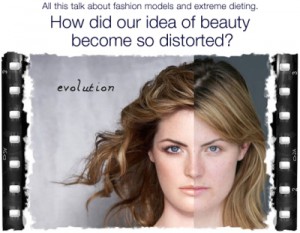
March 26, 2014, by Yvonne Teoh
Photoshop and Real Beauty
Has Photoshopped images of models and public figures gone too far?
With the recent rise of celebrities taking a stand against digitally altered photographs of themselves (e.g. Kate Winslet slamming GQ magazine back in 2005 for making her body unrealistically thin, Brad Pitt requesting for unedited portraits for his W Magazine cover in 2009), and certain multinational companies taking their own initiatives to encourage the public to accept their own beauty and flaws (e.g. Dove’s campaign for Real Beauty, and the more recent Aerie’s lingerie campaign featuring non-Photoshopped models), it is an intriguing topic, the way Photoshopped images affect the individuals’ views of their own body image. And does it only impact on our perception or does it also take a toll on our self-esteem, for both women and men?
At the rate these images are produced in our daily lives, from magazine covers, to the adverts in shopping malls, to the internet, it is difficult to completely ignore them. Hence, it is no surprise that Photshoppped images influence the way we set our standards of what beauty is, of what is seen as attractive and desirable. The trend that media portrayed since the 50s have changed over the years with a slow rising slope towards the idea of thinner is better, thinner is beautiful.
There’s a large body of research that have looked into how media affect individuals’ perception on attractiveness, body image and so on. For example, Ashikali & Dittmar (2012), and Ata et al. (2013) found that media leads to a negative perception of one’s body image. The constant impact on our beliefs and senses from the Photoshopped images often cause one to look at his/her own body and they begin to compare and ponder on whether they are as attractive as the person on the advert.
The dissatisfaction of one’s own body image can start a downward spiral from lower self-esteem or worse, depression (Hausenblas et al., 2013), to developing eating disorders (Vargas, 2013). Many models and public figures have admitted that they developed eating disorders from the stress and constant idea that the public is looking up to them as the ideal image of beauty (e.g. French model and actress Isabelle Caro, and Australian actress and model Portia De Rossi).
However, as mentioned earlier, the media have started to improve the standards of beauty, and in some countries, the government have started to step in (e.g. in Israel, a law was passed that prohibits advertisers and the fashion industry to employ models with unhealthy Body Mass Index (BMI), and the rule also regulates the use of Photoshop in photographs). There are also more awareness created by the media about the use of Photoshop, such as Dove’s campaign for Real Beauty (which have been running for a decade now), where they released a video that demonstrated the amount of makeup and post-processing involved to get a model prepared for a normal photoshoot. Hopefully with the rise in awareness, we are able to distinguish what is reality and fiction, so that these images would have a lower impact on how we evaluate ourselves and the body image of others. Moreover, we need to constantly remind ourselves of this phenomenon, and instead of striving for what is seen as beautiful in media, why not strive for what is truly important – a healthy body – and good for us in the long run.
References:
- Diller, V. (2011, July 7). Is Photoshop Destroying America’s Body Image? Huffingtonpost.com. Retrieved February 27th, 2014, from http://www.huffingtonpost.com/vivian-diller-phd/photoshop-body-image_b_891095.html
- Matsumoto, N. (2013, April 15). Photoshopped Fashion Models: Let’s Get Wise to Them. Psychologytoday.com. Retrieved on February 27th, 2014, from http://www.psychologytoday.com/blog/eating-disorders-news/201304/photoshopped-fashion-models-let-s-get-wise-them
- Ross, C. C. (n.d.). Why Do Women Hate Their Bodies? Psychcentral.com. Retrieved on February 27th, 2014, from http://psychcentral.com/blog/archives/2012/06/02/why-do-women-hate-their-bodies/
- Vargas, E. L. (2012, June 18). The Negative Effects of Media on Body Image. Applied Social Psychology. Retrieved on February 27th, 2014, from http://www.personal.psu.edu/bfr3/blogs/asp/2013/06/the-negative-effects-of-the-media-on-body-image.html
Yvonne Teoh
(PhD Student, School of Psychology, UNMC)
-
Post a comment

